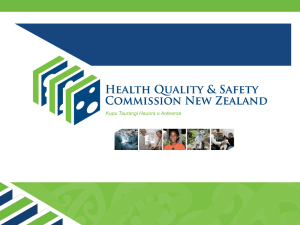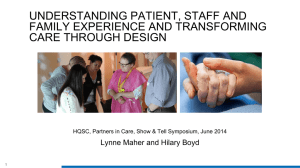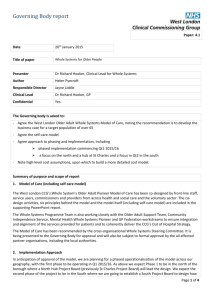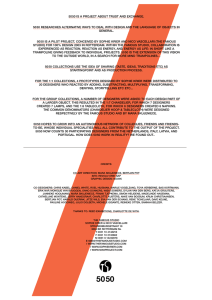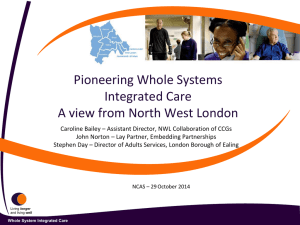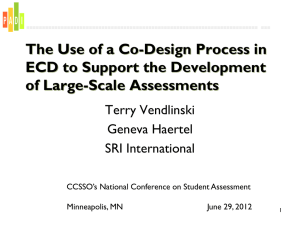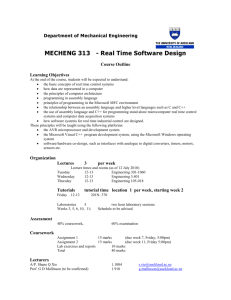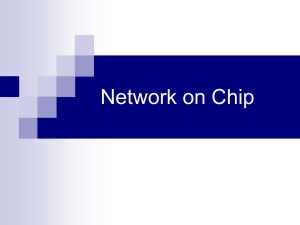NDIA Co-Design Framework 2015
advertisement
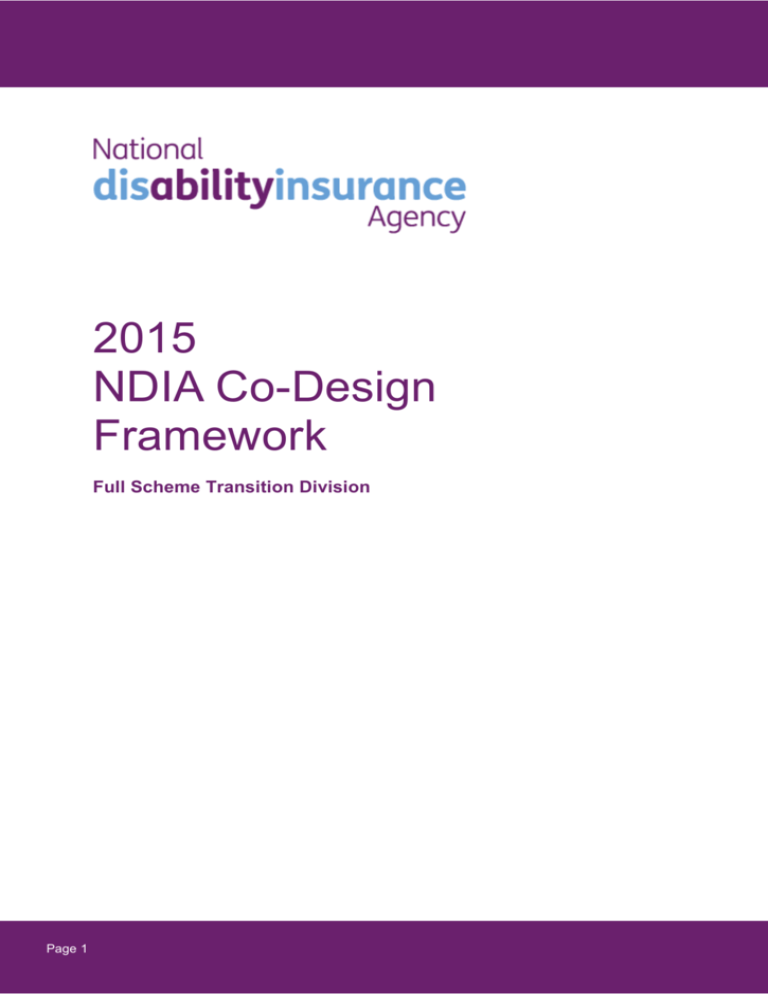
2015 NDIA Co-Design Framework Full Scheme Transition Division Page 1 2015 Co-design Framework National Disability Insurance Agency 1 Background Strategic Link – NDIA Strategic Goal 3: The community has ownership, confidence and pride in the National Disability Insurance Scheme and the National Disability Insurance Agency. Objectives To develop a co-design framework for the NDIA that is an agreed Agency approach which improve s outcomes for people with disability by: enabling the Agency, governments, the sector and people with disability to work together to place people with disability at the centre of what we do; outlining a methodology for carrying out co-design; providing a framework that will enable effective coordination, communication and facilitation to achieve meaningful engagement; and instilling a culture of continuous learning by encouraging internal and external stakeholders to understand, contribute, implement and improve on policies and procedures. The need for a framework Various co-design activities have been conducted in different areas of the Agency. An agreed co design approach ensures a more consistent and coordinated approach to co-design and the outcomes it aims to achieve. Co-design must be embedded more broadly across the Agency and build capability in co-design skills as an essential practice for achieving the NDIA’s strategic goals and objectives. This will help to facilitate the sharing of lessons across the Agency in support of a “Listen, Learn, Build, Deliver” culture. The approach to developing this framework The framework has adopted the ideas and methods from literature and a number of different broadly recognised co-design organisations. These ideas have been adapted to suit the Agency’s goals, objectives and current operational environment. The framework does not aim to cover the co-design process in extensive detail. Business teams will need to consider the best way to apply the principles and methods outlined in the framework to best suit their particular project or work objectives. Co-design can require a great amount of time, resources and capabilities to implement. As a new organisation transitioning to a national Scheme with priorities to be delivered in short time frames, it is important to recognise the constraints on the extent to which co-design can be executed. While the Co-design Framework sets a formal standard for how the Agency will grow and build capability towards achieving embedded co-design, effective planning must still be taken in order to understand how co-design relates to different projects and business goals. Page 2 2015 Co-design Framework National Disability Insurance Agency 2 What is co-design to the NDIA? Co-design can be used to solve a problem, validate a new operation or improve services. Co design will contribute to new insights, learning and building, which will ensure that the Agency continues to improve on its effectiveness and achieve greater outcomes for people with disability. The Co-design Framework establishes an Agency-wide approach to using co-design, including principles and methodology around when it is suitable to use co-design. It will ensure a consistent and coordinated approach which removes duplication and enables lessons to be shared. Defining co-design The term co-design has different meanings for different people. For the NDIA, co-design refers to involving the end-user of the service or experience in the design phase of a project or piece of work that aims to improve outcomes, such as service quality or solving a problem. Co-design is not just about gathering insights and feedback that may not be extracted through traditional research methods, but also provides an opportunity for the user to respond innovatively to address an issue. Co-design can create benefits for both the Agency and stakeholders. Above all it supports t he Agency’s “listen, learn, build, deliver” philosophy. Co-design is about learning when you don’t know the answer and learning when you think you know the answer by being open to hav ing your assumptions challenged. Co-design takes the needs of user as inputs into the design, allowing the design team to develop services and processes that balance perspectives from both the Agency and the user. Co-design should not be used as a PR activity. Co-design genuinely places the user at the centre of design so that we learn from those most affected by the change. Page 3 2015 Co-design Framework National Disability Insurance Agency 3 The Benefits of co-design Table 1: Specific benefits Benefits for the NDIA Benefits for stakeholders Page 4 Maintaining a participant-centred focus Improved communications between the Agency and key stakeholder groups Critical insights into and understanding of the experiences of the end user in order to address their needs Creating strong and productive relationships in support of the NDIS Improved ability to identify and manage risks early on in the design process Building community confidence in the NDIS and the Agency Building a culture of continuous improvement Validation and testing of ideas using lowcost rapid prototyping, resulting in decreased development costs Helps to generate a shared understanding of the priorities and purpose of the design Improving innovation and creativity Empowering participants to contribute directly to the design and evaluation of supports and services Higher satisfaction with services Improved understanding of the NDIS and the Agency Opportunity to voice their issues Increased understanding of the Agency, its goals and constraints Ability to positively contribute to the improvement of the NDIS Opportunity to connect and network with others, share experiences and collaborate to find solutions 2015 Co-design Framework National Disability Insurance Agency 4 Co-design Principles The following eight principles guide how the Agency conducts co-design. These principles will ensure good co-design practice, as they have been taken from different organisational frameworks and are for most part universal. The co-design principles include: 1. 2. 3. 4. 5. 6. Creating a shared understanding of the intent, objectives and goals of the co-design activity Taking a holistic, user-centred approach, based on story telling to help illustrate the context Engaging early and often Following a structured yet flexible process Ensuring there is representation from diverse stakeholder groups Taking into account the physical and emotional environment by making co-design activities accessible to enable meaningful participation 7. Managing expectations and clearly communicating constraints, so that stakeholders understand why some ideas aren’t possible 8. Closing the loop by being clear and timely about any follow up engagement, including the sharing of data, findings and next steps Page 5 5 Co-design methodology This methodology outlines the five phases of co-design. Co-design in not a linear process and the order of these phases m ay change dependent upon the project timelines, but the principles that underpin them remain unchanged. Figure 1: The Co-design methodology guideline Page 6 2015 Co-design Framework National Disability Insurance Agency Figure 2: The Co-design methodology Page 7 5 Levels of engagement This guiding framework sets the foundation for executing effective co-design and building strong stakeholder engagement, involving stakeholders at all levels to achieve the NDIA’s strategic outcomes. The Agency’s commitment to the Co-design Framework requires an understanding of the workload associated with properly implementing the framework as it is outlined. It is important to plan appropriately to address the resourcing needs to execute co-design effectively so the benefits can be realised. Levels of engagement: Most appropriate when: Not appropriate when: Co-design activities INFORM Stakeholders receive information without an expectation of twoway dialogue •There are constraints to using alternative forms of action •You are informing of decisions or promoting activity • People want to be involved • There is an expectation that twoway dialogue will occur CONSULT Options are presented to stakeholders, who provide feedback that can be incorporated in planning. The aim is to improve from broad stakeholders’ knowledge • You want to improve an existing service and require user feedback • You have limited range of options for improvement • Stakeholder interests can understand and relate to these options • You can use feedback to help select which of these options to use • Feedback will not inform final decisions • You aim to empower stakeholders in discussions • There are no clear options already determined and you are seeking a wide range of ideas before developing options Inform is not considered co-design, but may be used to start the co-design process to communicate the potential opportunity to participate etc. • Surveys • Online webform • Call for submissions • Focus groups • Prototyping • Flash cards • Role-plays INVOLVE Stakeholders are authentically involved in designing options • You need to tap into stakeholder needs and experience in order to design • Stakeholders have a strong desire to provide input • You cannot integrate broader input • You don’t have the resources or skills to carry out activity Page 8 • Interviews • Observations • Self-documentation (photo-diary) • Workshops • Visual probes • Flash cards • Role-plays • Prototyping 2015 Co-design Framework National Disability Insurance Agency Levels of engagement: Most appropriate when: Not appropriate when: Co-design activities EMPOWER Working together in partnership based upon shared goals. It is a lengthier, more complex process, which requires greater preparation and support for stakeholder involvement • It is important that stakeholders contribute to the development and implementation processes • There is benefit to the stakeholders and/or Agency from working together • Time is very limited • The commitment to partnership is not genuine • Stakeholders want to be involved but do not share a long-term goal or stake in achieving outcomes • Design workshops Example: When the framework is applied to the Service Delivery Operating Model (SDOM) codesign, Consult and Involve are the most appropriate levels of engagement. The SDOM design is participant centred and stakeholders are keen to contribute to the design. However, given the breadth of the design and limited time to deliver the design, the co-design cannot commit to and set expectations at the Empower level. Rather, appropriate methods will be used to effectively harness the insights by consulting and involving a range of stakeholders who interact with the Agency. Contact Us For more information: Please contact the National Engagement Team for more information by emailing engagement@ndis.gov.aau Page 9
